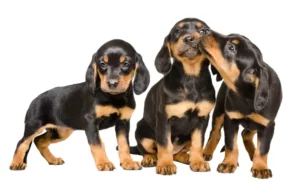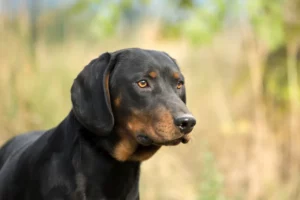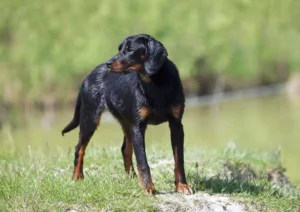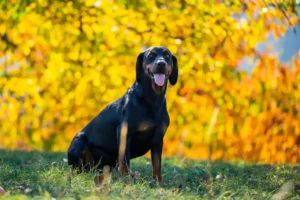Slovensky Kapov
The Slovensky Kapov, also called the Slovakian Hound or the Slovak Hound, is intelligent and energetic. A lively, hard-working, and capable hunter, it is popular in its native Slovakia for tracking and treeing. “Kopov” comes from the Hungarian “kopo,” meaning scenthound. Its characteristic black and tan coat, athletic build, and dark, soulful eyes are loved by many who keep it as a companion.
Slovensky Kapov Pictures




Quick Information
| Other names | Slovakian Hound, Slovak Hound |
| Coat | Short, coarse double coat with a thick undercoat |
| Color | Black and tan |
| Breed type | Purebred |
| Group | Scent Hound |
| Life expectancy | 12-13 years |
| Size | Medium |
| Height | 16 – 20 inches |
| Weight | 33 – 44 pounds |
| Litter Size | 4-6 puppies |
| Behavioral Characteristics | Energetic, intelligent, loyal, independent, and affectionate |
| Good with children | Yes |
| Barking Tendency | High; they can be nuisance barkers |
| Climate compatibility | High; they can adapt to various conditions |
| Apartment compatibility | Low; they require plenty of outdoor workouts |
| Do they shed | They are seasonal shedders |
| Are they hypoallergenic | No |
| Trainability | High |
| How much do they cost | $1,200 – $1,500 |
| Competitive Registration Qualification/ Information | FCI, UKC, AKC |
| Country | Slovakia |
History and Origin
The Slovensky Kapov has been used to hunt wild boar in its native country and Central Europe for centuries, honing its skills and abilities to become one of the finest tracking dogs, using its loud bark to alert its master of prey. The earliest written accounts are from the 17th and 18th centuries, forbidding cross-breeding to preserve the bloodline, indicating its existing popularity. It was likely developed using the Brandlbracke, Chart Polski, and Magyar Agar, first distinguished in the 1870s. Hunting regulations imposed in 1915, banning tall hunting hounds, led to a unified breeding approach and standard. During the World Wars, populations declined significantly, with Koloman Slimak organizing the first shows to find suitable breeding stock.
After several years of stabilizing its numbers, the FCI accepted it as a scenthound in 1963. The first Slovakian club, the Slovak Hound Breeders Club, was set up in Bratislava in 1988. It is currently part of the AKC’s Foundational Stock Service. Though extremely popular in Slovakia, it is still relatively rare worldwide.
Temperament and Personality
A determined tracker, it can stay on a scent trail for hours. Combined with its high intelligence and independence, this makes it a genuinely formidable hunting dog. Famed for its vigilance and loyalty, this is an excellent watchdog and guard dog. However, this can make it aggressive, and proper training is required to prevent excess barking, making it suitable for experienced owners. Its high energy levels need a master to provide plenty of outdoor play. This breed gets along well with children. Still, one should be careful around younger kids, or they might get hurt. Though highly faithful to its family, it tends to bond closely with one person who should be in charge of its care for it to feel comfortable.
Care
Exercise
These dogs are clever and have great stamina, requiring at least one and a half hours of adequate physical and mental exercise daily to stay healthy. Multiple daily walks, backyard play, and activities like hiking, swimming, and retrieving thrown objects are great ways to exhaust excess energy. Additionally, indoor games like chasing a ball across the floor, hide-and-seek, short hallway walks, and new tricks are great options. Scenting games and puzzle toys are also brilliant ways to provide mental stimulation. They also excel at dog sports like rally, agility, and obedience and are used for police work.
Grooming
Its short, compact coat is low-maintenance, requiring brushing only once or twice every week. The dense undercoat sheds seasonally, so you must practice regular brushing during this period. Use a slicker brush and wipe down afterward to keep its coat soft and shiny—a bath after every hunting trip is recommended, along with checking for fleas and ticks. The floppy ears are prone to infections, so check them diligently every grooming session. Trim the nails as necessary and clean the teeth frequently.
Health Problems
The Slovensky Kapov is an overall healthy breed, with common health issues being elbow and hip dysplasia, patellar luxation, eye problems, and ear infections. Purchasing your pet from reputed breeders can help avoid most of these concerns.
Feeding
Their diet should be prepared, considered a medium-sized dog with high energy. They do well on high-quality dog food, either store-bought or homemade. Feed them two to three times throughout the day to prevent overeating. A balanced meal should be mostly meat, with some fruit and vegetables, to meet the protein, carbohydrate, and fat requirements. Avoid artificial additives. Give treats in moderation as they tend towards obesity. Always provide clean, fresh water.
Training
Highly intelligent, they are quick learners. Training should begin at the earliest and continue lifelong, but avoid making it repetitive and boring, as they will not listen.
Socialization: Early socialization is necessary to avoid becoming mistrustful and wary of strangers. Consistent and firm leadership is essential as they are strong-willed and independent and can become stubborn if mismanaged. They can be naughty as puppies, constantly testing boundaries and taking advantage of any inconsistency. Always give them plenty of praise and positive encouragement.
Obedience: They are loud nuisance barkers, so you must train your pet to stop howling or barking on command.
Interesting Facts
- This breed is sometimes called the “Black Forest Dog.” This name is a misnomer, as it has no relation to the Black Forest region. The likely explanation is a confusion between the German term for this dog, “Schwarzwildbracke,” meaning Wild Boar Hound, and “Schwarzwaldbracke,” or Black Forest Hound.
- It is Slovakia’s sole native scenthound.
- Its popularity in its birthplace led to it being named the national breed of Slovakia.
FAQs
The correct pronunciation is “Slovensky Cop-of.”
The significant difference lies in their size, with the former being shorter and sturdier than the Black and Tan Coonhound.





